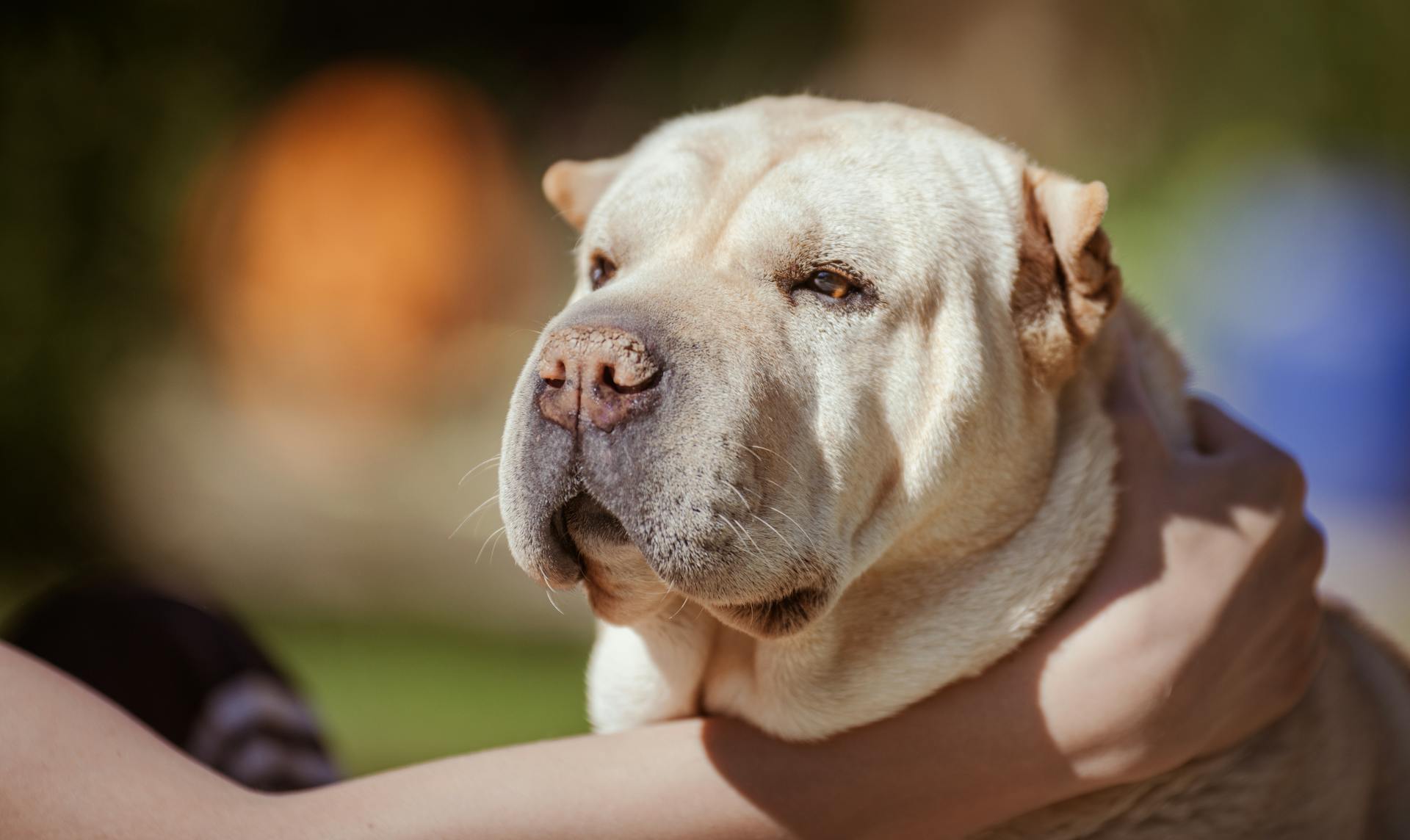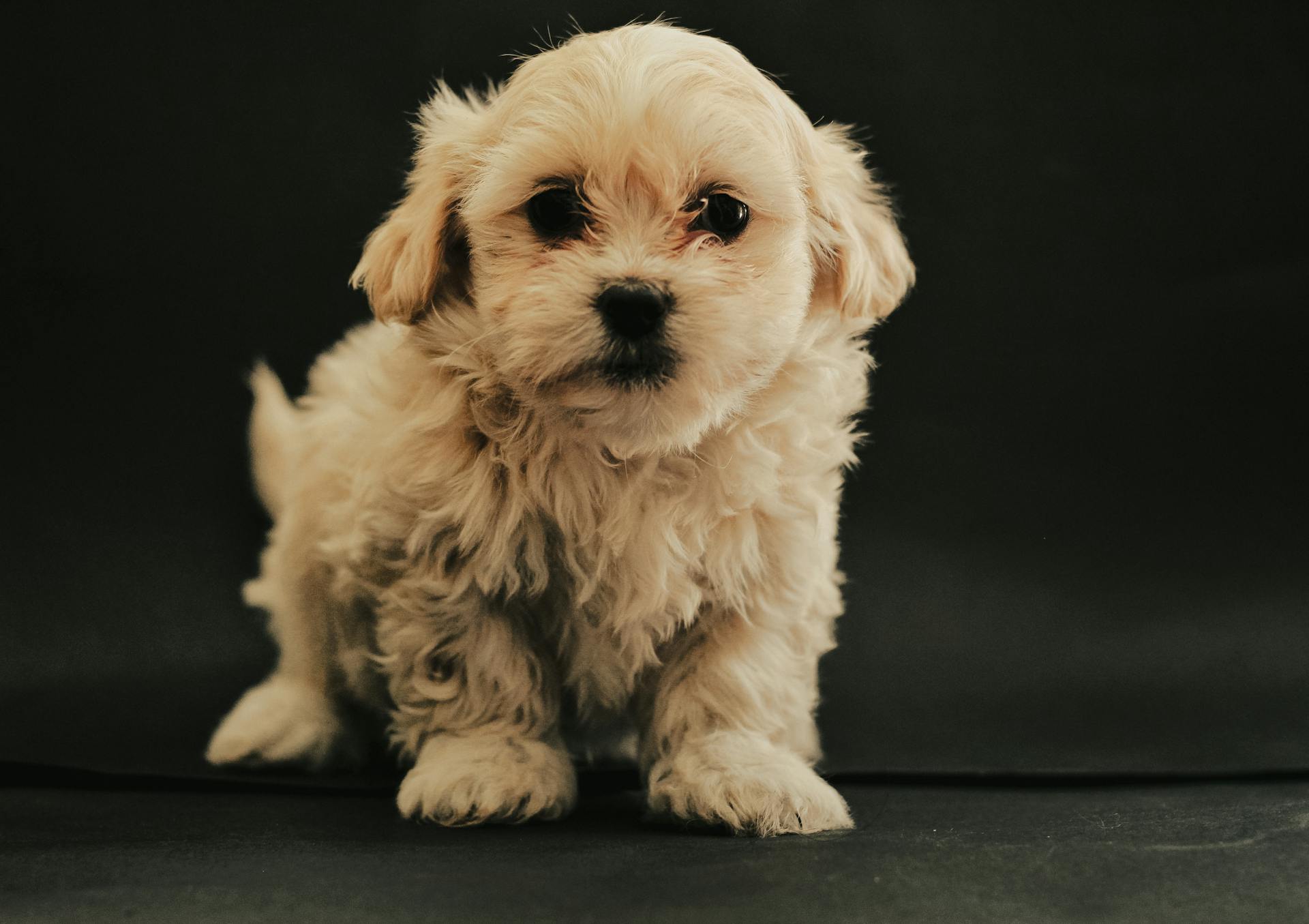
Dog faeces can be a breeding ground for various parasites and infections that can be transmitted to humans and other animals. Hookworms, for instance, can be found in dog faeces and can cause hookworm infections in humans.
These infections can lead to symptoms such as gastrointestinal issues, weight loss, and even anemia. Hookworms can also be transmitted through contact with contaminated soil or water.
Some of the most common parasites found in dog faeces include roundworms, tapeworms, and hookworms. These parasites can be transmitted through contact with contaminated faeces, soil, or water.
Dog owners should take precautions to prevent the spread of these parasites and infections, such as regularly cleaning up after their dogs and washing their hands thoroughly.
If this caught your attention, see: What Diseases Do American Dog Ticks Carry
Causes of Dog Faeces Diseases
Stress in dogs can cause a change in the normal intestinal bacteria, leading to diarrhea and digestive issues.
Good stress, bad stress, anxiety, or too much excitement can all trigger this imbalance.
Food poisoning from bacteria like Salmonella and E. coli can also cause a similar shift in intestinal bacteria.
This is because dogs, like humans, have a unique population of intestinal bacteria that help digest food.
A change in diet, even if it's just a different brand of kibble, can disrupt this balance and cause diarrhea.
This is because the intestinal bacteria get used to digesting one particular food, and a change can throw them off.
Curious to learn more? Check out: Water Diarrhea in Dogs
Transmission and Risk
You can get germs and illnesses from dogs in various ways, including through contaminated food and treats, water bowls, or surfaces.
People who are most at risk of getting sick from their dog include children, people ages 65 and older, pregnant people, and immunocompromised people.
The level of risk and who might develop a particular condition may also depend on other factors, including the specific bacteria, virus, fungus, or disease.
You can spread illnesses from dogs by picking up their poop and then touching your eyes or near your mouth.
In fact, a 2012 study in Finland shows that noroviruses are one of the leading causes of diarrheal diseases among people of all age groups and can survive in dogs and be passed along to humans.
Here are some ways dogs can spread germs to humans:
- They spread through contaminated food and treats, water bowls, or surfaces.
- You pick up your dog’s poop and then touch your eyes or near your mouth.
- You dog licks your face with their tongue and is carrying an infection.
- You sleep in the same bed as your dog.
- Your dog gives you cuts, scratches, or bites that break the skin.
Specific Diseases
Campylobacteriosis and Salmonellosis are two serious diseases that can be spread through contact with dog feces.
Campylobacteriosis symptoms can appear 2 to 5 days after exposure and typically fade away within 1 week, but they can be uncomfortable and include diarrhea, cramping, abdominal pain, and fever.
Some diseases are more likely to be linked to contact with dog feces than others, and Salmonellosis is one of them. It can be spread through contact with a dog that has the germ, its feces, or saliva, or even through contact with an item containing the germ and then touching your face or mouth.
Here are some key facts about these diseases:
- Campylobacteriosis symptoms can last up to 1 week.
- Salmonellosis germs can be shed in pets' stools for 4 to 6 weeks after infection.
Roundworms
Roundworms are a common parasite found in puppies and kittens, and it's estimated that nearly all puppies are born with them.
The roundworm that affects dogs is Toxocara canis, and it's usually visible in their stool or vomit, looking like thin spaghetti.
In kittens, most become infected after nursing, and the roundworm that affects them is Toxocara cati, which is also found in their stool or vomit.
Roundworm eggs are very resistant to chemicals and weather, and they can remain infective in the soil for years, leading to repeated reinfection.
These eggs are often found on the soil or grass, and as your pet walks by, they get picked up on their fur, which is then ingested during normal grooming.
The eggs hatch in the stomach, and the developing larvae mature in the small intestines, becoming adults in about three to four weeks.
At this point, the mature worms are able to reproduce and shed more eggs, which pass out the intestines in the feces and become infective in the soil in about one week.
See what others are reading: How to Become a Dog Trainer for Service Dogs
Whipworms
Whipworms are a type of gastrointestinal parasite that affects dogs, with Trichuris vulpis being the most common species.
The eggs of whipworms are incredibly resilient and can live in the environment for up to five years.
In order to become infected, a dog typically ingests whipworm eggs from the environment.
It takes about three months for these eggs to mature into adults and start shedding eggs.
Adult whipworms burrow into the small intestine and feed on blood and tissue.
The eggs are only intermittently passed in the feces, making diagnosis a bit tricky.
Repeated fecal examinations may be necessary to diagnose whipworm infection due to the eggs' unpredictable shedding pattern.
The eggs become infective again about a month after being passed in the feces.
Hookworms
Hookworms are a type of parasitic worm that can infect dogs and cats.
The most common hookworm in dogs is Ancylostoma caninum, while in cats it's Ancylostoma tubaeforme.
Hookworm eggs are relatively susceptible to cold weather and are usually destroyed after a hard freeze.
The eggs can be ingested, penetrate the skin, or be spread during nursing or through the placenta.
After ingestion, the eggs hatch in the stomach and develop into adults in about two weeks.
If the larvae penetrate the skin, it takes about four weeks for them to mature.
Once mature, the worms begin reproducing and shedding eggs in the feces.
It takes two to eight days for the eggs to become infective.
Adult worms attach to the lining of the small intestine and feed on blood, which can lead to severe anemia in severe infections.
A unique perspective: Types of Dog Skin Conditions
Giardia
Giardia is a one-celled organism that infects the small intestine of dogs and cats.
The symptoms in young animals can be severe, causing explosive, watery diarrhea, dehydration, weight loss, and an unkempt appearance.
Most cases of Giardia in young animals can begin as early as five days after exposure.
The eggs of Giardia are susceptible to chemical disinfection.
Adult animals can harbor the infection without showing clinical signs.
Cysts can appear in the feces one to two weeks after exposure to the infection.
Most domestic animals contract Giardia from drinking contaminated pond or stream water.
Coccidia
Coccidia are intestinal protozoa that invade and infect the lining cells of the small intestine.
Many species of coccidia exist and almost all domestic animals can become infected.
Of the numerous types that infect dogs and cats, Isospora is the most common.
Coccidia spread when an animal eats infected fecal material or an infected host, such as a small rodent.
Most coccidial infections are harmless and are eliminated by normal body defense mechanisms.
More serious coccidial infections cause severe watery or bloody diarrhea.
They are often seen in high-density confinement situations such as kennels, catteries, and pet shops.
See what others are reading: Service Dog Vest for Small Dogs
Tapeworm
Tapeworms are a rare but possible occurrence in people, usually happening when children accidentally ingest a flea that's been infected by their pet.
Typically, this happens when your pet swallows an infected flea and then you swallow a flea that bit your pet.
You may see tiny pieces of tapeworm, about the size of a rice grain, in your pet's poop.
Collars and pills, along with topical medications, can help keep fleas away.
Though some tapeworms can grow quite long, almost 3 feet, they aren't usually dangerous.
They're also relatively easy to treat.
A unique perspective: What to Feed Dogs If No Dog Food
Campylobacteriosis
Campylobacteriosis is a bacterial infection that can be spread to humans through contact with feces from dogs and cats carrying the bacteria. This is a common way the infection is transmitted.
Symptoms of campylobacteriosis can appear 2 to 5 days after exposure and typically include diarrhea, cramping, abdominal pain, and fever.
The good news is that most people can recover from campylobacteriosis on their own, with symptoms fading away within 1 week.
For your interest: Dog Diseases and Symptoms
Salmonella
Salmonella is a common pet illness that can be spread to humans through contact with a dog that has the germ or with the dog's feces or saliva.
You can get Salmonella if you come into contact with an item containing the germ and then touch your face or mouth.
Salmonella germs can be shed in pets' stools for 4 to 6 weeks after infection, making it essential to keep your home clean and your pet's environment hygienic.
A significant outbreak of Salmonella in 2019 was linked to pig ear treats, affecting dogs across the United States.
Leptospirosis
Leptospirosis is a serious disease that outdoor enthusiasts and their companion animals may encounter. It's caused by bacteria called Leptospira, which can be found in water, soil, and animals.
The signs of leptospirosis in dogs can be non-specific, making it challenging to diagnose. Common signs include loss of appetite, vomiting, lethargy, abdominal pain, diarrhea, jaundice, dehydration, and drinking or urinating more than usual.
Dogs may also develop severe lung disease, rapid breathing, and damage to the heart muscle. Some dogs may experience bleeding disorders, leading to blood-tinged vomit, urine, feces, or saliva, as well as nosebleeds and pinpoint red spots on the gums or skin.
A veterinarian may suspect leptospirosis based on the dog's exposure history and physical examination. They may recommend blood tests, urine tests, radiographs, and an ultrasound examination to confirm the diagnosis.
Leptospirosis is typically treated with antibiotics and supportive care. Dogs with severe disease may require fluid therapy, certain medications, and nutritional support. In some cases, intensive care measures like oxygen therapy, mechanical breathing support, or dialysis may be necessary.
Early treatment can improve the chances of recovery, but there's still a risk of permanent kidney or liver damage. In severe cases, a referral for dialysis may be lifesaving for dogs with struggling kidneys.
For another approach, see: Are Therapy Dogs Service Dogs
Sources
- https://www.rochesterhillsvet.com/articles/gastrointestinal_parasites_in_dogs.php
- https://www.healthline.com/health/humans-catching-from-dogs
- https://www.webmd.com/pets/ss/slideshow-diseases-from-pets
- https://www.avma.org/resources-tools/pet-owners/petcare/leptospirosis
- https://www.animalhospitalofmebane.com/services/dogs/blog/dog-diarrhea-it-happens-and-heres-what-you-need-know
Featured Images: pexels.com


